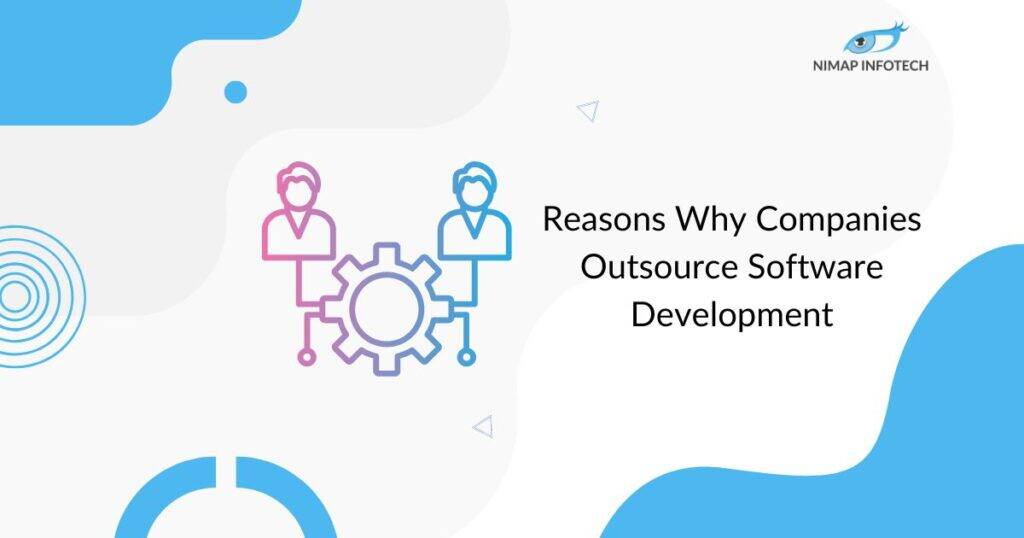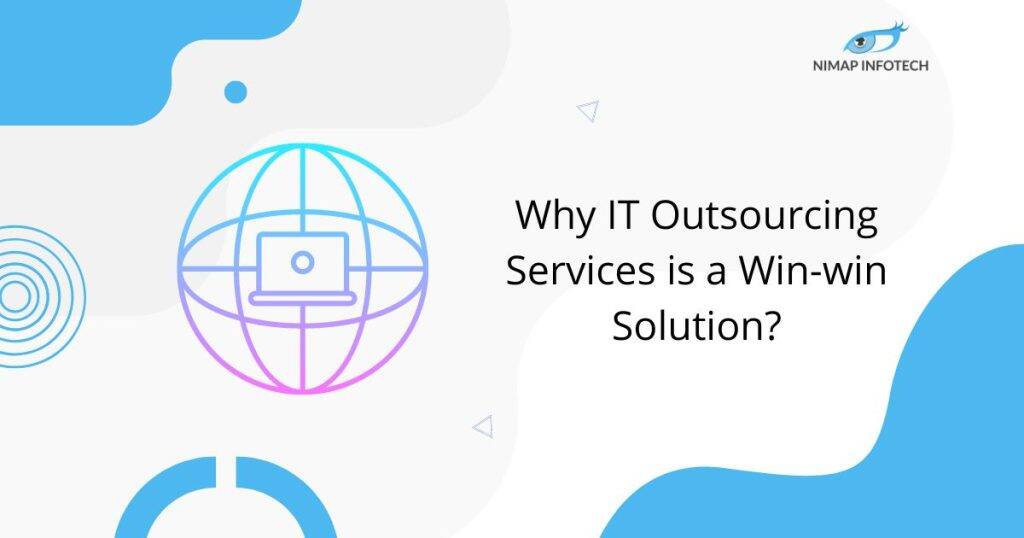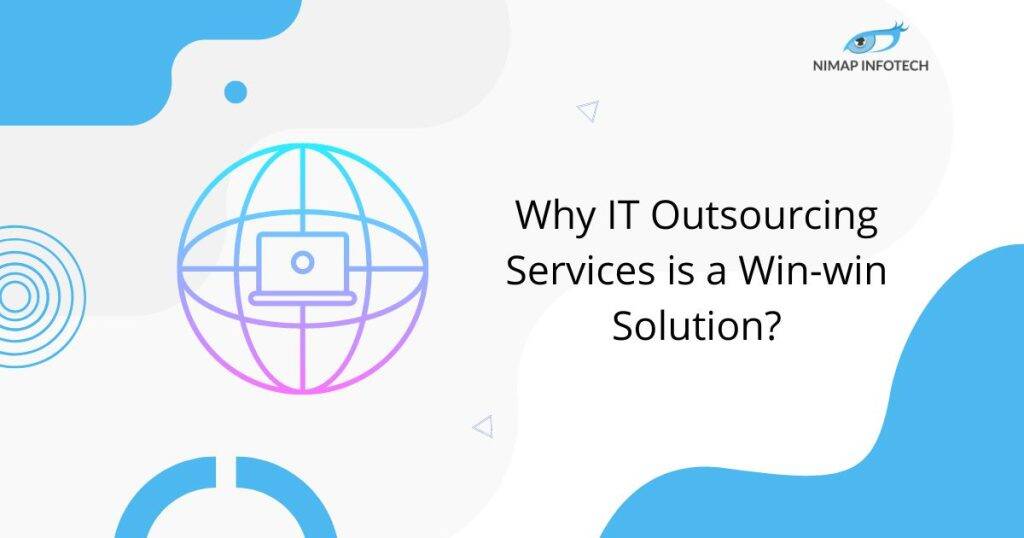It becomes critically annoying to choose whether we must outsource our software development services or not. Outsourcing software development services can be a game-changing step for escalating your business, as it not only drives growth but also saves costs and gets the software delivered faster. Whether you have planned to use software development services or you intend to use the power and services of an outsourcing software development plan, you must first focus on its benefits, its idea, and the steps that must be incorporated to deliver an excellent outsourcing software development services.
What is Outsourcing Software Development?
Outsourcing software development is a business strategy for delegating software development tasks or projects to an external company instead of executing them within in-house capabilities. The step to outsourcing software development begins when a business chooses to build a software project with the assistance of a third party.
In 2024, global IT outsourcing is projected to generate 351 billion USD. Companies of all sizes can obtain a competitive edge behind this startling statistic. Outsourcing enables them to finish IT projects more quickly with the expertise, technical talent, and adaptable team scalability provided by specialized outsourcing partners.
Reasons Why Companies Outsource Software Development
We understand that outsourcing software development is a big step that a company takes. Still, its demand is increasing daily, not only for giant or big capital companies but also for the unprecedented demand that small and startup companies witness. However, it is to be noted that with outsource software development, there is an unannounced risk that might be perpetuated if we deviate from our goals and strategies. Here are the top 7 reasons companies outsource software development services:
Reduced Business Cost:
One of the most important reasons why businesses choose to opt for outsourced software development is that it allows them to retrench or cut back their costs. According to data by Deloitte, roughly 59% of organizations outsource to cut or control their costs. Cutting expenses helps companies as it gives them more money to invest in other aspects of the operation (hiring more staff, upgrading hardware and software, expanding offices, raising compensation, etc.). Outsourcing is a more cost-effective alternative for businesses for several reasons.
Decrease in Overhead:
With potential savings of up to 60%, when you hire outside labor, you pay for their services; you don’t have to cover overhead costs like hardware, software, rent, sick leave, or training.
Lowers Hiring Expenses:
The majority of software development outsourcing is completed online, and it is far quicker and less expensive than recruiting internally. Just a few clicks will get you all the details and endorsements/reviews you need to get a sense of their expertise.
Gain Access to World-class Talent:
Through outsourcing software development, businesses can interact with the world’s top experts no matter how far away they are from one another. It’s not a case of attempting to hire people as full-time employees: the gig economy means that collaborations can occur for one-off projects with no future responsibility. Pleasant surprises might sometimes arise from working project-by-project with specialists. Software engineers can find possibilities to improve a product and take the initiative to put ideas in motion, even though a corporation will give them a clear brief and targets to meet (after consulting with the business, of course).
Reduces Hiring Costs and Time:
There are several phases involved in hiring new software developers. The first step is to post an application on different websites and/or search LinkedIn for suitable applicants. After narrowing down the pool of candidates to the best, interviews come next. Finding a suitable time window requires juggling schedules, which could cause the process to take longer than expected. Any full-time developers you get on board need to be versatile and fit for all the future initiatives your company wants to take on. That makes the hiring system even more complicated and time-consuming. Requirements for training also result in additional delays and expenses.
Power of Flexibility:
When you choose to outsource software development services, you tend to discover the power of flexibility. You can scale your workforce up or down as needed via outsourcing, which can provide you additional flexibility. If you need to expand your capacity temporarily or are experiencing quick expansion, this can be useful. By partnering with a respectable business that has a solid track record, you lower your risk.
Reduce the Risks Associated With Your Project:
Even when market research indicates a high chance of success, creating and marketing new items is inherently risky. However, taking risks can be extremely challenging for SMEs and startups that are expanding into new markets or that don’t have a tried-and-true method for developing profitable products. Even after investing time, money, and effort in recruiting full-time developers and covering overhead for several months, a company’s product may still not succeed. This can have disastrous effects and, in the worst situations, be unrecoverable. Instead, it works incredibly well to outsource software development to other businesses. Dealing with a team that makes use of a top-notch project management system, has set up a productive workflow, and has demonstrated experience in producing applications that yield a strong return on investment can help you reduce the risks involved in product development.
Steps for Successfully Outsourcing Software Development
The following are some of the key steps you must incorporate when you want to create a successful outsource software development project.
Make Your Business Requirements Clear:
You must be clear about the needs and business goals of your product before contacting a possible software development partner. This is important for a technical vendor to develop precise project specifications and identify the proper technology stack to build your software solution.
- You can ask yourself the following sequence of questions for this purpose:
- Which pain point or problem do I want software to solve?
- What corporate goals do I have for this software?
- For whom am I creating the digital solution or solutions?
- What is my solution-creation budget and timeline?
- Which software functionality modules are essential?
- Does new software need to be integrated with processes or systems that already exist?
When you gather answers to these questions and start thinking about its outcome effectively, you tend to build a clear vision for the product and services that you plan to deliver or receive.
Look for Someone Who is an IT Outsourcing Provider:
The simplest method to locate an outsourced software development business is to look through reputable B2B service provider sites like Clutch or GoodFirms, which compile a list of tech vendors. Filters by location, service, hourly rates, budget, and other criteria can be applied there to provide an overview of the company. Once you have identified the company that best fits your needs and requirements, visit their website to submit a request. If you intend to outsource your labor, stick to fair developer fees. To make it work, further consider the labor regulations, tax structure, language ability, and cultural distinctions of the chosen area.
Decide Among: Onshore, Offshore, or Nearshore
The location of each possible vendor is important to consider when selecting an outsourcing partner because it can impact not only the final product’s quality but also its communication, efficiency, and cost. Based on firm location, software development outsourcing organizations have classified themselves into three categories: onshore, offshore, and nearshore outsourcing, to analyze and consider available possibilities. When you choose to outsource your software development service in your nation it is referred to as “onshore outsourcing” or “onshoring.” Selecting an outsourcing partner with headquarters in a far-off nation is known as offshore outsourcing or offshoring. Selecting an outsourcing partner with a base in a nearby nation is known as nearshore outsourcing, also known as near sourcing or nearshoring.
Select an Outsourcing Model:
For different types of outsource software development projects, there are different types of models. These are project-based outsourcing, managed teams, and staff augmentation. Select the model that best suits your needs, financial situation, and future goals.
Staff Augmentation:
This technique entails temporarily hiring employees from a different company, usually to finish a project. The major goal of this is to close the talent gap in your company. The external employees follow your instructions while assisting your team in winning. This group will frequently report to your internal project manager and collaborate with your internal team. This methodology, in contrast to the Staff Augmentation model, usually does not require you to manage specific personnel on a day-to-day basis.
Virtual or Managed Teams:
The managed teams model combines elements of the project-based approach (discussed below) and staff augmentation (see above). When you work with managed teams, you may assign part or all of your project to a group of professionals that include front-end and back-end developers, designers, QA engineers, business analysts, and more.
Project-based Model:
This outsourcing model hands team management over to your outsourcing partner’s Project Manager, who will work with you to set schedules and explain your demands to their colleagues. Outsourcing projects doesn’t mean giving up whole control. You will continue to have a say in important choices like feature creation and setting priorities. It implies that managing the outsourced crew won’t be a concern for you. It’s the least involved choice offered.
Evaluate the Profile of the Selected Tech Partner:
Once you have chosen the tech partner, go through his profile. Understand this expertise and areas of success, then make sure to align them systematically with your project requirements. Consider his domain expertise as it will help him to understand the processes, challenges, trends, and different intricacies of your business. Technical expertise. Before assigning the product construction task, confirm that the company has a lengthy history in IT operations and a strong foundation in a variety of technological fields. In this manner, the group can provide you more complete software that seamlessly combines several technologies. Portfolio of work. Who has the company previously worked for? Have they shipped any goods that resemble yours? Discover vendor’s experience through successful case studies for a certain industry. See how they developed digital solutions to assist clients in meeting their business difficulties.
Schedule a Meeting:
You can get in touch with suppliers via their websites after you’ve selected three to five possible tech partners for your shortlist. For consultations, get in touch with their specialists, request a portfolio, and learn everything there is to know about their collaboration and software product delivery strategy. Before you even start talking, find out if the organizations have signed a nondisclosure agreement (NDA) to protect the privacy of your data.
The main topic of discussion between you and an IT supplier is comprehending you:
- Context of business: corporate needs.
- Specific issues you’d like software to address.
These are necessary for the team to define the functional scope, offer a tech solution, estimate the amount of work that will be needed, and establish expectations for the product. The vendor also takes note of any limits you may have: time for the project, budget limitations, cooperation preferences, regulatory constraints, etc.).
Make Proposals:
You can ask for offers when the initial call has been completed and everyone on the team feels that the project demands are understood. Proposals are sales pitches meant to persuade you that the team is aware of your specific business needs and product specifications and is capable of offering a technological solution that will successfully address your problems. These proposals usually contain an approach to app development, a methodology, a suggested fix, the makeup of the team, a development schedule, and an estimate of the associated costs.
Execute a Collaboration Contract:
Once the outsourced IT provider that best suits your needs has been chosen, seal the deal by signing an extensive contract. The scope of work, project schedules, deliverables, price terms, responsibilities, intellectual property rights, confidentiality agreements, and other pertinent terms and conditions should all be spelled out in the outsourcing contract.
Software Outsourcing Models, Which You Must Know
If you are planning to outsource your software development project, then before proceeding ahead, here are a few models of outsource software development that you must learn about.
1. Location-based Software Development Outsourcing Models:
The distance between the client and the team or service provider determines these software development outsourcing methods. Through location-based outsourcing, businesses can also obtain knowledge that is not already available to them. For instance, because the American financial system is generally more developed, an Asian fintech app developer may need to work with a US-based financial expert.
2. Onsite Outsourcing:
When an outsourced workforce works at your physical location, this is known as onsite outsourcing. The hiring process is frequently handled by a third-party source, who will then send the team onsite after it is finished. An off-site workforce operates in the same manner as your internal employees. The primary distinction is that, although they aren’t officially your employees, they are still third-party service providers. The good news is that this strategy is cost-effective because there are no expenses associated with onboarding, training, or benefits. Because the outside crew is on-site, they are also more able to quickly adjust to your processes, which is another benefit of onsite outsourcing.
3. Onshore Outsourcing:
When you collaborate with an outside team located in your nation, though not always in the same city, this is known as “onshore” outsourcing. Convenience and a smooth transition are your primary reasons for choosing onshore outsourcing. As you both come from the same nation, there is no cultural or linguistic barrier. Time zone differences are typically negligible or non-existent. That means your team may start work on the project immediately with minimum alterations. Like onsite outsourcing, the main disadvantage is that domestic talent is your only option. That could result in a scarcity of competent talent or excessive developer rates. Nearshore outsourcing is typically used by medium-sized to large businesses that can afford the increased development costs in exchange for better communication and possibly a better development team.
4. Offshore Outsourcing:
At the opposite end of the spectrum is offshore outsourcing, when you collaborate with a development team in another country, frequently halfway across the world. For many businesses, the most popular approach is offshore outsourcing. This is because it is the most economical model. You can choose to work with the least expensive developer that yet meets your standards for quality. As the development team frequently works during your company’s off-peak hours, the time zone difference may also be advantageous to you. This implies that assignments can be given during the day and that you may receive them first thing in the morning. However, working on offshore outsourcing projects might be difficult. In addition to the time zone difference, a language and cultural barrier might exist.
5. Nearshore Outsourcing:
A client who wants to employ a development team in a neighboring country can use the nearshore outsourcing approach. The time zone difference between a nearshore country and your home country is typically less than three hours. A German company that employs our DECODE team in Croatia is a prime example of a nearshore arrangement. You can benefit from nearshore outsourcing by taking advantage of both onshoring and offshoring. You minimize time zone disparities, gain access to a large talent pool and reduce developer costs. If you choose a nation that shares your language, you can even lower barriers based on language and culture.
6. Multisource Outsourcing:
Outsourcing with multiple sources employing many teams to work on different aspects of your app project is known as multisource outsourcing. You have the best freedom when you outsource to several vendors. It is possible to hire more expensive specialists to work on crucial project areas while hiring less expensive generalists to handle the majority of the job. When multi-sourcing is done correctly, it can help you discover the best teams for the job while optimizing your app expenses. The consequence, however, is that it’s tougher to communicate and manage multiple teams. This is particularly true if the work of one team depends on the output of another team, meaning that even minor delays might cause your project as a whole to lag.
Advantages of Outsourcing Software Development
The ability of outsourcing to spur innovation is one of its main benefits. Businesses can take their software development projects to new heights by utilizing outside knowledge and new viewpoints.
You Get Entry to Specific Abilities:
Through software development outsourcing, one can gain access to a worldwide talent pool of highly qualified individuals with specialized technical knowledge. This is especially helpful in the following situations.
Taking on Sophisticated Technology:
It can be difficult to locate local knowledge of specialized technologies like artificial intelligence. You can save time and money by working with an outsourcing partner to supply the technical skills required for these specialized fields.
Creating Creative Solution:
Software outsourcing firms frequently have experience with a range of sectors and technologies, which helps stimulate creative thinking in software development. Working on software projects with an outsourced team can help you come up with new concepts and solutions.
Outsourcing is a Tool for Strategic Expansion:
Outsourcing not only saves development expenses but can also be used as a growth strategy.
Scaling Swiftly:
Without requiring substantial hiring or training, software development outsourcing enables businesses to scale their projects quickly. You may easily add knowledgeable software engineers to your team, meet deadlines, and manage huge projects effectively by working with an outsourced software development business.
Achieve Economic Stability:
By leveraging cost benefits, IT outsourcing provides a workable way to achieve economic stability. Organizations can save expenses, distribute resources more effectively, and possibly reinvest savings into other strategic projects by choosing outsourcing partners in locations with lower labor costs. Both resource optimization and financial stability are aided by this strategy.
Key Risks to Avoid When Outsourcing Software Development
You now have comprehensive information on software development outsourcing and the reasons it’s a highly favored strategy for contemporary organizations thanks to the aforementioned primary benefits. However, this approach also has several drawbacks and hazards. Making decisions requires decision-makers to critically assess their project. Let’s quickly review the main drawbacks of outsource software development.
Communication Difficulties Leaving Vapours in Delivery and Execution Expectations:
Teams working on outsourced software projects frequently find it difficult to communicate with one another due to linguistic, cultural, and geographic barriers. Remote cooperation increases the risk of failed outsourced software projects by causing misalignment of expectations, decreased insight into crucial objectives, and delivery delays. For this reason, 90% of IT companies steer clear of outsourcing their important software product development initiatives.
Data Security Issues Making It Risky to Share Important Business Information:
Outsourcing may put the business at risk for data security. Sharing confidential information with outside parties raises the risk of breaches or leaks, which can seriously harm the status and reputation of the business. As such, data security must be given top priority by those in charge of protecting sensitive information. To protect sensitive data, robust security measures, including encryption and access controls, must be put in place.
Effective Quality Assurance and Adherence to Industry Guidelines:
Even though outsourcing can be efficient and cost-effective, it can also be challenging to guarantee that the finished product will live up to expectations regarding quality. This is where the responsibilities of heads of operations and product managers—who normally handle regular monitoring and evaluation come into play. By remaining watchful and proactive, these experts can guarantee that outsourced software development projects fulfill the company’s quality standards and produce the intended outcomes.
Essential Factors to Consider When You Outsource Software Development
Proficiency:
The abilities of your potential developer outsourcing contractors are the first thing you should consider since they are essential to making your business vision a reality. Naturally, choosing the precise technological stack may be difficult if you have no prior expertise in digital development. Don’t worry, though; the company of your choice will take care of everything for you. The crucial thing is to state in your request what business niche you are interested in and define the major technologies (if any) needed for the implementation of your project.
Costing:
The cost of your potential digital partner is another crucial point that you should make clear. It could rely on the location in addition to the company’s reputation and field of expertise. Since some nations have lower average market prices for software development services, a great deal of cooperation can help you cut the project budget without sacrificing the project’s quality of execution.
Co-operation Models:
Certain firms focus exclusively on offering outsourced services in a particular structure, such as dedicated teams. Thus, ensure that the contractor supports the type of cooperation you require before signing a contract with them.
Communication:
It might be challenging for some business owners to engage in fruitful collaboration with teams that speak a language different than their own. The same is true of communication techniques and approaches; they can either support or obstruct productive project completion. For this reason, before your contractor begins working on your business plan, you must have these details.
Different Time Zones:
Such cooperation is unlikely to be pleasant if you are limited to making phone calls at night to your contractor. Thus, take advantage of the chance to select an outsourcing software provider with a headquarters in a nation with a comfortable time zone.
How Much Does It Cost to Outsource Software Development?
Location of the Service Provider:
Rates differ significantly based on geographic location. For example, developers in North America or Western Europe may charge between $100 to $250 per hour, while those in Eastern Europe, India, or Southeast Asia can charge between $20 to $80 per hour.
Type of Project:
- Simple projects (e.g., small websites, and basic mobile apps) may cost anywhere from $5,000 to $50,000. Medium complexity projects (e.g., custom business apps, e-commerce platforms) range from $50,000 to $150,000. Complex projects (e.g., enterprise software, large-scale SaaS platforms) can exceed $200,000.
Team Composition:
- The number of developers, designers, testers, and project managers involved will affect the overall cost. A full team with specialized roles can cost significantly more than hiring a small team or individual developers.
Project Duration:
- Long-term projects require continuous investment, whereas short-term projects might have a one-time fixed cost.
Technology Stack:
- Different tech stacks have different costs due to varying levels of expertise needed and tool licensing fees (e.g., AI development might be more expensive than building a simple website).
Time Zone Co-ordination & Communication:
- Nearshore outsourcing might be more expensive than offshore outsourcing but offers smoother collaboration due to smaller time zone differences and similar working hours.
Additional Costs:
- Hidden costs can include time spent managing the project, training the outsourced team, and integrating external teams into your company’s processes. A detailed project scope and a breakdown of deliverables are crucial for getting accurate cost estimates from vendors.
How to Develop Effective Software Outsourcing Strategy?
To develop an effective outsourcing strategy:
Identify Core Needs:
- Clearly define which tasks or processes you want to outsource, focusing on non-core activities to free up internal resources.
Set Clear Goals:
- Establish measurable objectives like cost reduction, efficiency, or access to specialized skills.
Choose the Right Partner:
- Research potential outsourcing vendors for expertise, reliability, and cultural fit.
Define Scope & Expectations:
- Specify deliverables, timelines, and performance metrics to ensure alignment.
Maintain Communication:
- Establish regular touchpoints and a feedback system to monitor progress and address issues.
Mitigate Risks:
- Include data security, legal, and compliance measures in contracts.
Why Nimap is the Best Choice to Outsource Software Development?
At Nimap, we take great satisfaction in our ability to provide high-performance, customised software solutions that are made to fit the particular requirements of our clients in a range of sectors, including insurance, e-commerce, travel, and fintech. Our approach to developing custom software is based on a thorough comprehension of the goals and operations of our clients. We specialize in producing efficient, scalable, and high-performance software that is not merely a technical solution, but a strategic value to our clients’ organisations. Our entire technology stack, which includes, among other things, scalable in-memory processing systems, modern lightweight Java development, mobile-friendly web applications, and reliable databases, complements this strategy and guarantees that we have the resources and know-how to tackle any challenge.
Author
-

Sagar Nagda is the Founder and Owner of Nimap Infotech, a leading IT outsourcing and project management company specializing in web and mobile app development. With an MBA from Bocconi University, Italy, and a Digital Marketing specialization from UCLA, Sagar blends business acumen with digital expertise. He has organically scaled Nimap Infotech, serving 500+ clients with over 1200 projects delivered.
View all posts








